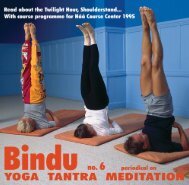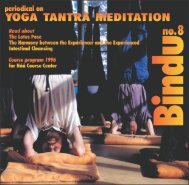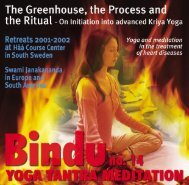Bindu 23 - engelsk 7.p65 - Scandinavian Yoga and Meditation School
Bindu 23 - engelsk 7.p65 - Scandinavian Yoga and Meditation School
Bindu 23 - engelsk 7.p65 - Scandinavian Yoga and Meditation School
Create successful ePaper yourself
Turn your PDF publications into a flip-book with our unique Google optimized e-Paper software.
the sexual element of Tantra in my<br />
book to refute the idea (which certain<br />
orthodox yogis had tried to spread) that<br />
yoga required absolute chastity.<br />
However, I will say in defence of<br />
celibacy that it has a great effect in<br />
relation to one’s spiritual strength <strong>and</strong><br />
determination, as long as one does not<br />
do it with fanaticism <strong>and</strong> turn “the lust<br />
of the flesh” into something sinful or<br />
dirty, in order to defend oneself against<br />
it.<br />
If one cannot or does not want to<br />
live in brahmacharya (actually, “to be<br />
one with the whole - with the all,”<br />
commonly interpreted as celibacy) for<br />
the whole of one’s life, it is<br />
recommended to keep celibacy during<br />
the periods where one works intensely<br />
with oneself <strong>and</strong>/or goes through an<br />
initiation. Then there is a greater<br />
chance of a breakthrough to true<br />
calmness, insight <strong>and</strong> stability.<br />
Continence, or a moderate or<br />
economical sex life, can bring about<br />
quite a different strength <strong>and</strong><br />
invulnerability - compared to the<br />
perforated, depressed or emotionally<br />
irritable state, one is in, without<br />
knowing why, when maintaining an<br />
exaggerated or disharmonious sex life.<br />
The Tradition<br />
There is no doubt that a teacher, when<br />
he or she has finished the training, can<br />
grow <strong>and</strong> become unique in relation to<br />
his or her teacher - however, to teach<br />
from the tradition implies that a direct<br />
break with the teacher does not take<br />
place. My relationship with Swami<br />
Satyan<strong>and</strong>a has evolved from just<br />
being a pupil, to the somewhat closer<br />
relationship of being a disciple, to a<br />
period where I had to show what I<br />
stood for, each day - time in itself gave<br />
me no credit; to a friendship, to<br />
something more, based on great mutual<br />
respect for each other, based on an<br />
experience of unity <strong>and</strong> on an<br />
acknowledgement of each other’s<br />
differences. (See also <strong>Bindu</strong> no. 5.)<br />
How does this relationship start? A<br />
short quotation from my diary in India:<br />
The fear that exists of everything<br />
new,can also emerge during learning,<br />
when ideas <strong>and</strong> expectationsmingle<br />
with underst<strong>and</strong>ing.<br />
The teacher must be able to take away<br />
fear from the pupil,<br />
so that the pupil can experience <strong>and</strong><br />
underst<strong>and</strong> the new<br />
without hindrance -<br />
<strong>and</strong> in so doing later meet <strong>and</strong> conquer<br />
fear on his own,<br />
with greater wisdom <strong>and</strong> strength.<br />
And another time, under different<br />
circumstances, I wrote:<br />
To slate your teacher,<br />
in your thoughts or in front of others,<br />
does not change reality, <strong>and</strong><br />
does not entitle you to take something,<br />
to which you have no claim.<br />
I cannot take credit for the yoga I teach<br />
or for Kriya <strong>Yoga</strong>; nor can my teacher<br />
Swami Satyan<strong>and</strong>a - although, the way<br />
I see it, he has really shed light upon<br />
Kriya <strong>Yoga</strong> - <strong>and</strong> nor can his teacher<br />
Swami Sivan<strong>and</strong>a, no matter how great<br />
pedagogues they were <strong>and</strong> how much<br />
they have brought forth from the<br />
tradition.<br />
With this attitude, peace of mind is<br />
maintained, <strong>and</strong> one can teach without<br />
the fear that arises when one is assertive<br />
at the expense of others, or takes credit<br />
for something which can not be owned,<br />
or is stolen (in the sense that one<br />
reduces one’s dem<strong>and</strong>s on oneself <strong>and</strong><br />
on the conditions of teaching).<br />
The pupil can, nevertheless, very well<br />
become an exceptionally good teacher.<br />
“The disciple may well be psychically<br />
higher developed than oneself” Swami<br />
Satyan<strong>and</strong>a said (one evening in<br />
Gondia, where we rested between two<br />
of our arrangements, in a private home<br />
where we stayed as guests - “we” were<br />
a small group of 9 people, on a 3<br />
months tour round northern India).<br />
But who can compare?<br />
The answer came one day when he<br />
said to me: “Have respect for where<br />
you are, <strong>and</strong> be who you are, then all<br />
thoughts of who is higher or lower, in<br />
front or behind, lose meaning.”<br />
Liberation, when seen from this<br />
point of view, lies in being yourself -<br />
<strong>and</strong>, as I see it, in looking upon life as<br />
a gift <strong>and</strong> receiving this gift. Not what<br />
you are going to achieve tomorrow, or<br />
the unpleasant events that might come,<br />
but what happens now, is where you<br />
really live the life that you after all<br />
have been given. Without fear of how<br />
others live <strong>and</strong> without the wish to live<br />
like others - thereby frustration <strong>and</strong><br />
misery are avoided.<br />
Concerning the teaching of Kriya <strong>Yoga</strong>,<br />
then the task is entrusted to you, you<br />
are permitted, <strong>and</strong> you are prepared for<br />
it <strong>and</strong> tested - beyond what even a<br />
comprehensive yoga teacher education<br />
otherwise consists of. That is why, so<br />
far, it is only swamis who teach the<br />
tradition I have chosen to teach from.<br />
“Earlier, Kriya <strong>Yoga</strong> was only for us,<br />
the swamis, it was our meditation. It<br />
was secret <strong>and</strong> we used it for our own<br />
sake. It was only passed on to the ones<br />
who had taken sannyasa.”<br />
(Swami Satyan<strong>and</strong>a).<br />
Also see the two previous articles on<br />
Kriya <strong>Yoga</strong> in <strong>Bindu</strong> no. 4 <strong>and</strong> 5.<br />
27











